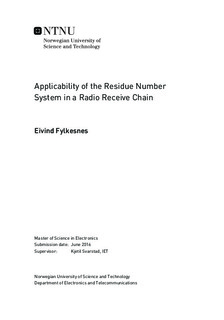Applicability of the Residue Number System in a Radio Receive Chain
Master thesis
Permanent lenke
http://hdl.handle.net/11250/2405571Utgivelsesdato
2016Metadata
Vis full innførselSamlinger
Sammendrag
This thesis explores the residue number system and how it can be used in a radio receiver. In this number system the numbers are divided up into several residues. Each of these residues is associated with one particular modulus. The main advantage of this number system is that, during arithmetic operations like addition and multiplication, the calculation for each residue can be done in parallel, independent of one another. This advantage can be utilised to improve the performance of several of the operations done in a radio receiver.
In this thesis the operations FIR filtering, both using real and complex coefficients, and scaling is implemented using the residue number system for scaling and real FIR filter and the quadratic residue number system for the complex filter. In addition are RNS to binary and binary to RNS converters implemented. Both the RNS implementations of all these operations and their corresponding binary implementation are run through simulations to get data on their power consumption and area usage. The simulations are done for ASIC using a 55 nm technology library.
The results illustrate that the chosen implementation of FIR filters, both real and complex, does not provide an advantage over the binary implementation unless the dynamic ranges required in the filter are very large. For filters covering dynamic ranges above 32-bit, the area per tap is less for the RNS filter than for the binary. The power consumption per tap is assumed to be lower for filters with dynamic ranges above 24-bit. The overhead by conversion increases as the dynamic ranges increases and thus counteracts the increased gain per tap in the same situation. The overhead by scaling is shown to be minimal, in therms of both area usage and power consumption, compared to the other components implemented in this thesis.
